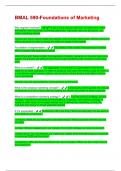BMAL 590-Foundations of Marketing
Why segment markets? - ✔️✔️To get a more precise definition of customers needs
and wants, more accurate marketing objectives, improved resource allocation, and
better marketing results
Consumers have unique needs and desires. Due to these differences, different products
will be required in order to satisfy the different needs in the market
Foundation of segmentation - ✔️✔️The ability to find smaller homogeneous markets
within a larger heterogeneous market
Often times with these smaller homogeneous markets, demand can become less price
elastic: consumers are willing to pay more to get something that is closer to what they
want
What is a market? - ✔️✔️The aggregate of all people or organizations who have a
need for, or want, a product or class of products and have the money to pay for them. It
is sometimes used to mean a place, real or virtual, where buyers and sellers meet to
buy or sell goods
Markets may be segmented by characteristics of the buyer
What is the classical marketing concept? - ✔️✔️A philosophy which guides the attitude
of everyone in a firm to stimulate and satisfy the needs and wants of every customer
What is a competitive marketing strategy? - ✔️✔️It involves product strategy, pricing
strategy, integrated marketing communications, channels, and logistics strategy. It
needs to offer value to the target market, that is defined by marketing, so that the
business may focus on those selected markets
5 C's (expanded) - ✔️✔️Customers: Who are they? What are they like? Do we want to
draw different customers?
Company: What are our strengths and weaknesses? What customer benefits can we
provide?
Context: What is happening in our industry that might reshape our future business?
Collaborators: Can we address our customers' needs while strengthening our business
to business (B2B) partnerships?
Competitors: Who are the competitors we must consider? What are their likely actions
and reactions?
,STP (expanded) - ✔️✔️Segmentation: Customers aren't all the same; they vary in their
preferences, needs, and resources.
Targeting: Attracting some of those customers makes better sense than going after
others.
Positioning: Communicate your benefits clearly to your intended customers.
4 P's (expanded) - ✔️✔️Product: Will customers want what your company is prepared
to produce?
Price: Will customers pay what you would like to charge?
Place: Where and how will customers purchase your market offering?
Promotion: What can you tell your customers, or do for them, to entice them to
purchase?
Customer behavior - ✔️✔️The way customers select, purchase, use, and dispose of
goods, services, ideas, or experiences to satisfy their needs and desires
Business-to-customer (B2C) - ✔️✔️(Customer involvement: low) Convenience
purchases: Staples (standard, frequently consumed goods such as bread or gas) and
impulse purchases (candy or National Enquirer available near the check-out stand).
(Customer involvement: moderate) Shopping purchases: Going online to
Citysearch.com to find a restaurant and make reservations when heading out of town.
(Customer involvement: high) Specialty purchases: A new car, fashion shows, an
expensive laptop computer.
Business-to-business (B2B) - ✔️✔️(Customer involvement: low) Straight rebuy: You're
out of toothpaste and you mindlessly pop a tube of your usual brand into your basket.
(Customer involvement: moderate) Modified rebuy: You reach for your brand of
toothpaste but you try a new flavor.
(Customer involvement: high) New buy: You're buying teeth whitening strips for the first
time and think what attributes must you consider.
Types of Shopping: Customer Involvement - ✔️✔️It's not the type of product or
purchase that matters. It's the type of customer behavior (consumer or business level of
involvement) that is relevant and the marketing actions and reactions.
, Customer involvement - ✔️✔️Low customer involvement: Customers don't care and
won't spend time thinking about brands. They will typically be somewhat price sensitive.
Moderate customer involvement: Some effort is expended prior to purchase to obtain
good value.
High customer involvement: For expensive purchases, brand, uniqueness and quality
matter.
Buying Process - ✔️✔️The steps consumers go through when buying a product or
service
1. Identify needs/wants
2. Search for alternative solutions
3. Evaluate alternatives
4. Purchase
5. Evaluate post-purchase
Consumer buying - ✔️✔️People buying something for themselves or their household
Business customer - ✔️✔️A business customer is an agent buying something on
behalf of an organization.
Models of how buyers make decisions - ✔️✔️1. Lexicographic method
2. Average method
3. Use attribute importance
What is marketing? - ✔️✔️It is involved in designing products that customers will enjoy,
pricing them appropriately, making them available for purchase at easy points of access
in the marketplace, and advertising the products' benefits to the customers.
5 C's - ✔️✔️customer, company, context, collaborators, competitors
STP - ✔️✔️Segmentation, Targeting, Positioning
4 P's - ✔️✔️Product, Price, Place, Promotion
How is marketing an exchange relationship? - ✔️✔️The customer seeks benefits from
the company and expects to pay.
The company offers benefits to its customers and seeks profits.
Why is marketing important? - ✔️✔️Enriches society, can be entrepreneurial, expands
global presence, strengthens channel relationships




